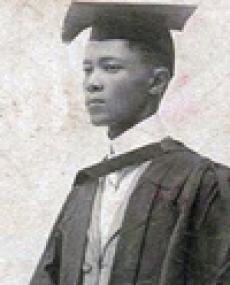
Harold Cressy was born on 1 February 1889 in Rorkes Drift, KwaZulu Natal. He was one of the five children of Bernard and Mary Cressy. The local Roman Catholic Mission School provided Cressy's primary education and at the age eight he was sent to Cape Town to continue his education. In 1905 he graduated from Zonnebloem College with a T.3 certificate, which was the basic requirement for teachers.
In 1906, at the age of seventeen, Cressy was employed as principal of the Dutch Reformed Church mission school at Clanwilliam. It was there that he was exposed to the injustices of the Cape's segregated education system. At the same time he continued his studies and obtained his matriculation certificate in 1907. His hard work earned him a study bursary from the Department of Education and he applied to the Rhodes University College.
His application was successful, but the university refused him entry when they learned that he was a Coloured man. Cressy then applied to the Victoria College at Stellenbosch, now the University of Stellenbosch, and was rejected on the same grounds.This did not prevent him from attempting to study elsewhere. His application to the South African College, now the University of Cape Town, was controversial because Dr Abdullah Abdurahman, president of the African Political Organisation (APO) and Cape Town city counsellor, used his influence to force the college to accept Cressy. In 1910 he graduated from the University with a Bachelor of Arts degree. After his studies he found employment as a teacher at St Philip's Primary School and involved himself in APO activities. He was not focussed on political activism and protest, but rather the improvement of Black people's education in South Africa.
In 1912 Cressy was appointed principal of the Trafalgar Second Class Public School, which had been established in 1910. It was the only school to offer secondary level for Coloured learners. His appointment saved the school from closure. He laboured tirelessly to raise the reputation of the school by improving standards. Together with the APO he pressured the Cape Town city council to find suitable accommodation for the school. After five years the city council agreed to provide a better site for the school and the Cape School Board donated 3 000 pounds for the erection of a new building. In September 1912 Cressy married Caroline Hartog. Despite the obstacles that Cressy faced he continued to further his education and received a T.2 certificate and School Music Certificate in 1912.
With the encouragement of Dr Abdullah Abdurahman, Cressy co-founded the Teachers' League of South Africa (TLSA) and was elected president of the league in June 1913. He was also elected first editor of the Educational Journal set up by the TLSA.
In 1916 Cressy fell victim to the severe pneumonia. He was advised to move to Kimberley where it was expected that his health might improve. On 23 August 1916 Cressy died. He was 27 years old. In October 1918 his wife fell victim of the Great Influenza Epidemic.